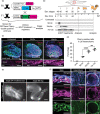Inducible and tissue-specific cell labeling in Cre-ERT2 transgenic Xenopus lines
- PMID: 35581155
- PMCID: PMC9328194
- DOI: 10.1111/dgd.12791
Inducible and tissue-specific cell labeling in Cre-ERT2 transgenic Xenopus lines
Abstract
Investigating cell lineage requires genetic tools that label cells in a temporal and tissue-specific manner. The bacteriophage-derived Cre-ERT2 /loxP system has been developed as a genetic tool for lineage tracing in many organisms. We recently reported a stable transgenic Xenopus line with a Cre-ERT2 /loxP system driven by the mouse Prrx1 (mPrrx1) enhancer to trace limb fibroblasts during the regeneration process (Prrx1:CreER line). Here we describe the detailed technological development and characterization of such line. Transgenic lines carrying a CAG promoter-driven Cre-ERT2 /loxP system showed conditional labeling of muscle, epidermal, and interstitial cells in both the tadpole tail and the froglet leg upon 4-hydroxytamoxifen (4OHT) treatment. We further improved the labeling efficiency in the Prrx1:CreER lines from 12.0% to 32.9% using the optimized 4OHT treatment regime. Careful histological examination showed that Prrx1:CreER lines also sparsely labeled cells in the brain, spinal cord, head dermis, and fibroblasts in the tail. This work provides the first demonstration of conditional, tissue-specific cell labeling with the Cre-ERT2 /loxP system in stable transgenic Xenopus lines.
Keywords: Cre-ERT2/loxP; Xenopus laevis; fibroblast; inducible cell labeling.
© 2022 The Authors. Development, Growth & Differentiation published by John Wiley & Sons Australia, Ltd on behalf of Japanese Society of Developmental Biologists.
Conflict of interest statement
The authors declare that there is no conflict of interests.
Figures




Comment in
-
Versatile Utilities of Amphibians (part 1).Dev Growth Differ. 2022 Aug;64(6):264-265. doi: 10.1111/dgd.12805. Dev Growth Differ. 2022. PMID: 36088539 No abstract available.
References
-
- Ai, H. W. , & Campbell, R. E. (2008). Teal fluorescent proteins: Characterization of a reversibly photoswitchable variant. Small Animal Whole‐Body Optical Imaging Based on Genetically Engineered Probes, 6868, 6868OD. 10.1117/12.761423 - DOI
-
- Esteves de Lima, J. , Blavet, C. , Bonnin, M. A. , Hirsinger, E. , Comai, G. , Yvernogeau, L. , … Duprez, D. (2021). Unexpected contribution of fibroblasts to muscle lineage as a mechanism for limb muscle patterning. Nature Communications, 12(1), 3851. 10.1038/s41467-021-24157-x - DOI - PMC - PubMed
-
- Fei, J. F. , Schuez, M. , Knapp, D. , Taniguchi, Y. , Drechsel, D. N. , & Tanaka, E. M. (2017). Efficient gene knockin in axolotl and its use to test the role of satellite cells in limb regeneration. Proceedings of the National Academy of Sciences of the United States of America, 114(47), 12501–12506. 10.1073/pnas.1706855114 - DOI - PMC - PubMed
MeSH terms
Substances
Grants and funding
LinkOut - more resources
Full Text Sources

